Controversy and gun handling techniques go hand in hand. Any time there is a new technique introduced or an unorthodox technique gets widespread exposure (no matter how long it has been in use), there will be all manner of instructors, shooters and spectators chiming in on the usefulness or stupidity of the technique. Recently, the technique that has found itself in the cross hairs is the technique that has been popularly referred to as “temple index.â€Â
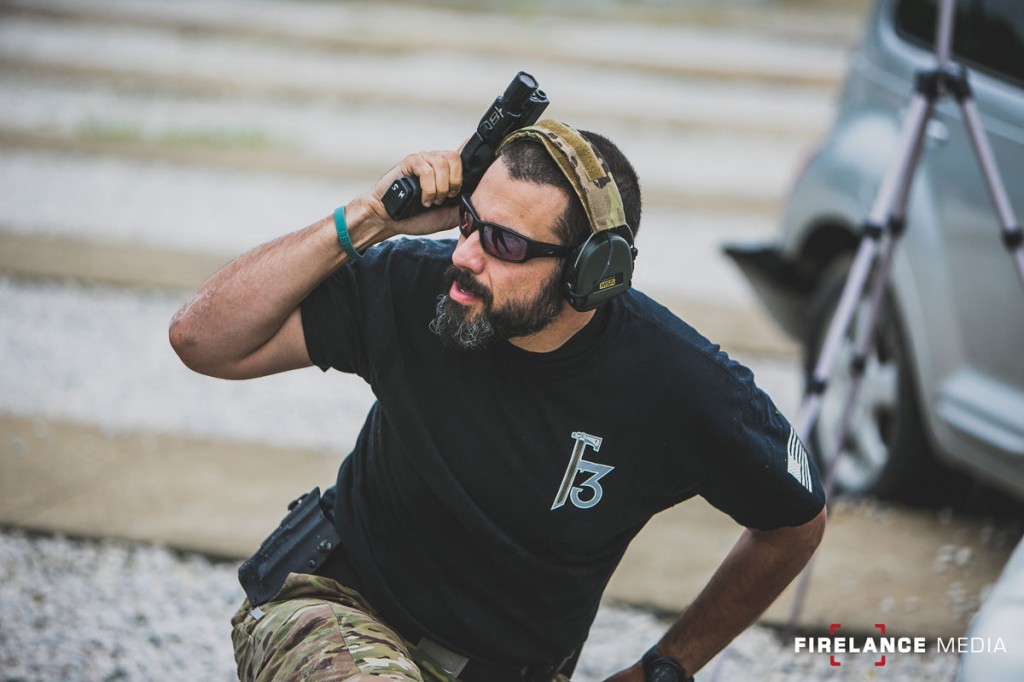
Temple Index – Firelance Media
As with any controversy, context is often ignored and speculation is based on third party explanations, personal opinions or photographs without details. Perhaps the worst culprit of all when it comes to these industry-driven debates and arguments is the rattling of the range mentality mindset and how it hurts far more than it helps. None more so than in the case of a real-world applicable technique that is demonized or dismissed because it somehow doesn’t apply to this-or-that training methodology as it is viewed through the lens of use on the range.
We train on the range, we practice on the range. We are not training to fight on the range.
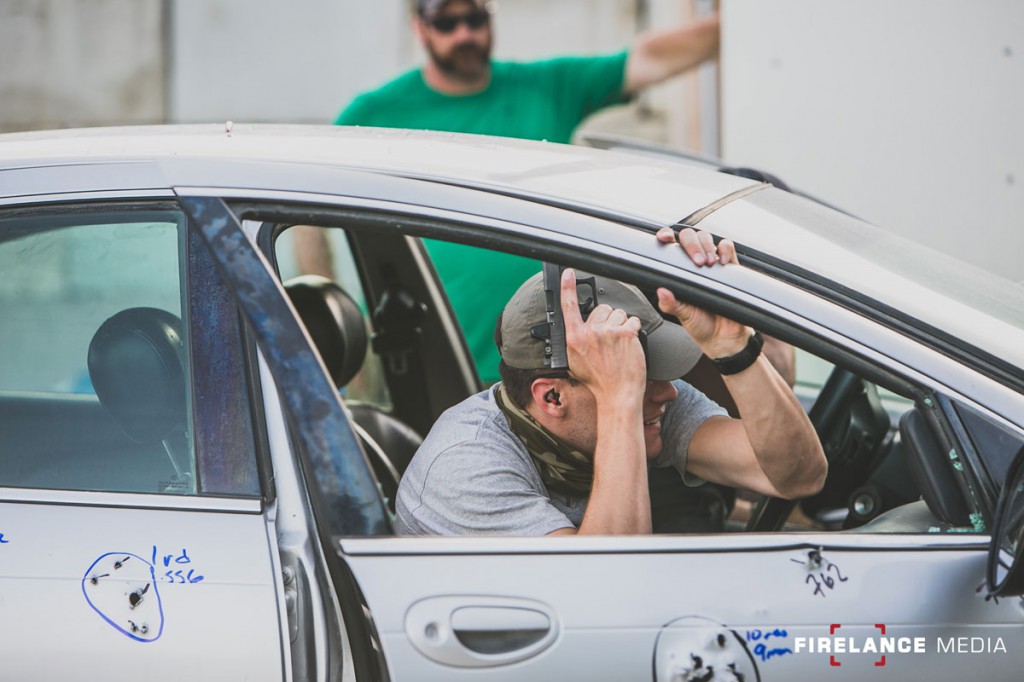
Temple Index – Firelance Media
The history of the Temple Index position is a long and storied one; though its exposure to the contemporary training world is recent.   When I first learned it, the technique was introduced to me as High Vertical Ready and it was for use maneuvering inside a vehicle for Personal Security Detail purposes. It was used to safely pivot in a seat without muzzling other passengers to engage a threat inside or outside of the cabin. As anyone who has worked PSD knows, sometimes there are possible threats inside the vehicle with your client and everyone outside the car is a possible threat. Being able to maneuver in a seat with weapon drawn, be it with your family, fellow officers, soldiers, detail members or general passengers is tricky business with few physical techniques.
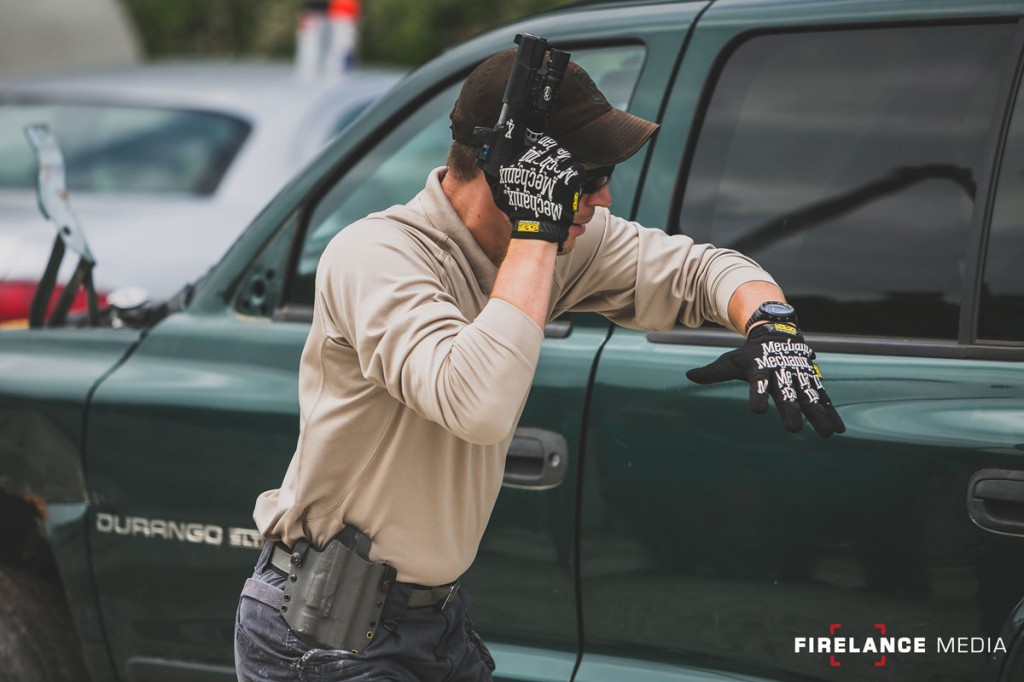
Temple Index – Firelance Media
The next time I saw it, it was called High Ready and it was explained as a safe method to avoid muzzling unknowns as you exit a vehicle, especially in crowded areas and explained as a method to use as/if you move to the rear of the vehicle to access rear storage to bring more guns to the fight or to make your way to hard cover. Anyone who has ever sucked into a car or even an SUV body knows that moving in a crouch leaves little safe places to point your weapon if the horizontal isn’t an option.
My last training encounter with Temple Index was in regards to the rifle; it was called High Port and it was taught by a Naval Special Warfare veteran as a method to maneuver the weapon (in this case, a rifle) through deep snow/brush and to navigate tight spaces or move quickly when running with a barrel-down would lead to a lot of barrel/leg contact. Running with a long arm, especially as part of a team, leaves few ways to carry your rifle without muzzling others and the navigation of tight quarters or less-than-ideal terrain a problem with few solutions.  Crowding into a hallway, or tunnel and needing to get your rifle into the fight from muzzle up is much easier than muzzle down for obvious reasons.
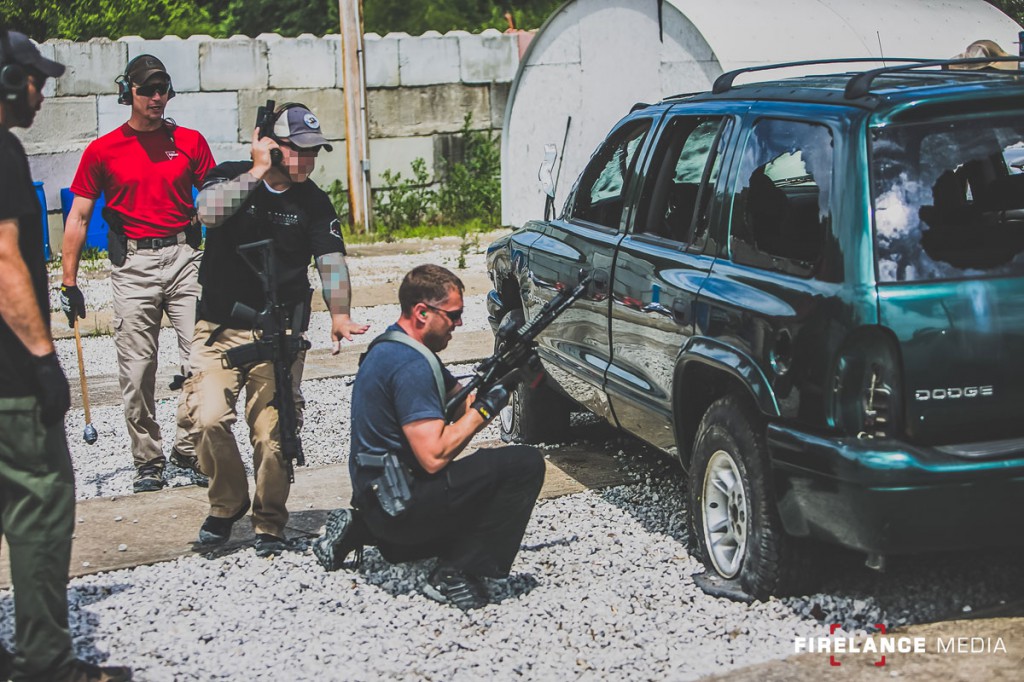
Temple Index – Firelance Media
With any technique, context is very important. If a technique is taken out of context, or defended by someone who doesn’t have a full appreciation of the context, it only makes matters worse. However, the most damaging aspect of any debate regarding any applicable technique is range mentality. Ranges are neat places with ideal footing, convenient targets, clean lines and most angles in the 90 degree family. Few are urban streets, cramped huts, parking lots, construction sites, wadis or escarpments. Ranges usually have all the bullets going in one direction and everyone is fairly certain that anything needing shot will be in that direction. We know the range and the range is a safe place so long as safety is observed. Â
Up is usually a frowned upon direction to point one’s weapon because of gravity. On the range we always have a safe direction to point our weapon and that is either down range or down at the ground. Well, the range is not the real world and the real world doesn’t have a down range. It’s also worth mentioning that pointing your weapon down in the real world may also not be an option because there may be people under you, you will muzzle yourself as you run, crouch-walk, or in the case of a single wide trailer used as a meth lab; explosions because meth labs generally do not react well to gun fire and through the roof is better than into the milk crate containing who knows what.
When I train students, be they citizen or LE, safety is taught in regards to the real world. If there is a safest place to point a weapon when not in use, that’s where it should be pointed.  This is the paramount safety rule of self-defense focused instruction; known safe direction over unknown safe direction. What do I mean? If I am exiting a vehicle and there are store fronts, pedestrians, occupied vehicles or residential homes in my arc, the weapon should not be pointed that way. Up, or Temple Index is the safest known direction that also allows crouched movement, running or exiting of the vehicle with the handgun already drawn (especially for right handed shooters).
In regards to a rifle, what methods are there to exit and not muzzle the horizontal? With all due respect to some instructors speaking out against Temple Index, High Port, High Vertical Ready or whatever the nom de guerre is, the weapon must be pointed in the safest known direction and that is usually up in such circumstances. Can there be a negligent discharge? Absolutely there can and if there is, we know that the fired round has the potential to injure someone as it returns to earth. Is this more or less of a risk than having a negligent discharge as the rifle/pistol is leveled at a home, a playground, a line of cars at a red light or a store front? I know there are people in the latter, so the former is the safest direction to point the weapon in that circumstance.  How fast can you run in a SUL position without muzzling yourself? Better yet, where do you point your muzzle when you do run?  Let’s not ignore the existence of other safety rules such as trigger finger discipline because in this case all it does is highlight an instructors subjective disdain or disagreement with a technique based on range mentality and/or lack of experience/instruction with a valid technique.
If I’m working through a crowd of screaming kids and/or adults fleeing a shooter, where is my weapon? Up, or down where any physical contact can keep it from the fight? Is there a right answer to that question? I would say not one right answer, but a wrong answer would be any answer that assumes the range and a real life shooting play by the same rules.
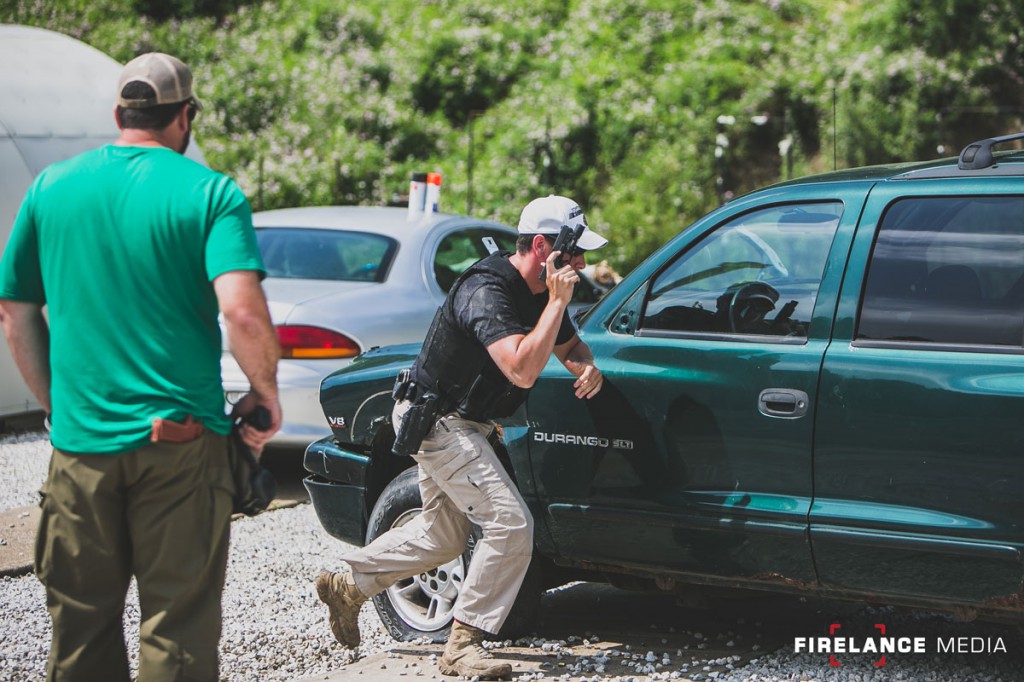
Temple Index – Firelance Media
Context, Context, Context
I really cannot say that enough. This is not the newest SUL position, and even SUL is seriously overused or incorrectly applied by shooters from all backgrounds. Temple Index is for very specific circumstances and stands alone as one of many tools. Weapons do not exist on wires or operate inside of imaginary limit boxes. They can and should be pointed in a safe direction any time they are not needed to gain compliance or incapacitation of a threat. That safest direction is dictated by where you are forced to fight, not by some unbreakable rule that demands range-like compliance in the real world.
There are many quality instructors teaching Temple Index, and they are teaching it in context. William Petty, a Texas LEO and trainer (and the man who coined the term Temple Index and was/is the source of much “controversy†for teaching it) Steve Fisher of Sentinel Concepts, Chris Costa of Costa Ludus, Jeff Gonzalez of Trident Concepts, and myself of Sage Dynamics are just a few trainers teaching this technique in the context in which it belongs.
It’s a valid technique, and despite much fuss it’s here to stay, particularly since it’s been in use by some accounts since the early 70’s, has survived countless real-world uses without failing to prove its usefulness and has only recently gained widespread attention thanks to the internet.   There is nothing unsafe about Temple Index by its necessity, only by using it out of context when other options would prove safer based on the situation. If those other options don’t exist or are not as prudent, Temple Index, when performed correctly, allows the shooter to maintain full awareness and move as safe as the situation will allow until the muzzle can be redirected.
So the controversy aside, I do hope this helps put things in a different light for some, or at least give context to those shooters/instructors that were not sure of or who were speaking out against the technique without having it properly explained.  It’s a tool, and it’s a tool you would be foolish to ignore if you want to use the “real-world training†shingle on your door.

Thank you again for the perfect explainations
Love seeing this type article in here. Thank you.
Thoughtful, and well-reasoned explanation. I hope people listen!
Well as a old guy we first saw the temple hold on TV. It was used to show the actor and the weapon in the same “head shot” on the small screen (see any cop show from the 60’s and 70’s). It then worked it way into real life, just like Adam 12 was training for some departments.
Great Post!!
Totally agree with this article. Many techniques are situational. Start with the “safest”, explain why, then teach the exceptions and explain why you may use it. Tools for the toolbox.
Perfect!
I work on COPE (Coordenadoria de Operações Policiais Especiais – Special Operations Police Department) here in Brazil and we are using the Temple Index since watched a Sentinel Concepts video on youtube. As rightly mentioned by Aaron “With any technique, context is very important. If a technique is taken out of context, or defended by someone who doesn’t have a full appreciation of the context, it only makes matters worse.”.
Congratulations on your text! I’m following your articles and videos on the internet!
Regards to all!
glad we could help
Bom trabalho cara!
Dwayne dieter was teaching this to NSW and training facilities like Blackwater in 2006. It makes sense but we live in a society of “range-isms”. I still remember before thus time, the mantra ” muzzle down, shoot the ground, muzzle high shoot the guy”.
I agree that as practitioners we need to look at all tools or techniques of our art form when it comes to combative situations. But on another note we need to stop thinking to hard and train for real world situations and not to imitate a big instructor and his or her way of teaching. Take what they say and teach and mold it into your own in a safe and effective way.
Robert with W.T.D.
How is the temple better than middle of the chest high ready? (I totally just made that name up. Could call it the modified step 3 I guess.) It’s a slight modification of your normal draw, instead of completely changing it, for a specific situation. I’m a big believer in muscle memory, esp in stressful situations.
What does bringing it to your temple achieve that “chest high ready” doesn’t? You can use your weak hand to open doors, easy to go to either one hand shooting or continue to step 4 of a normal draw. It doesn’t restrict your view, and your weapon is in a safe direction,
I keep hearing about using it maneuvering inside of a vehicle, but sticking your gun up by your ear let’s the threat, easily see you have a weapon. Why give him that information unnecessarily, he’ll figure it out soon enough.
I’m not trolling, and I’ve never used this technique. I’m trying to understand why it’s better from people who have been trained and have used it.
Loren,
The largest difference is muzzle direction… If there are things in our horizontal arc of movement we dont want to muzzle, or quarters are too tight to use a high chest compression, temple index is an option. Once of the biggest points of confusion is treating Temple Index as another “ready” position, which it isnt. The safest direction to point a weapon on a range is easily determined, not so much in the real world. With regards to working inside a vehicle, its difficult to maintain muzzle safety in any horizontal position with other passengers.
So many this.
Just to clear up any misunderstandings. I do not have a problem with the gun being pointed up. I used the high and low ready, situation dependent. So take that whole aiming up/aiming down argument off the table. Not an issue (for me)
My issue is bringing the gun all the way up to the ear. When I talked about Modified step 3, I was assuming the gun was in a high ready. Middle of chest, muzzle pointing up. (The only time it wouldn’t be possible in a vehicle is if you are sitting behind the steering wheel, with body armor on.)
So Mod 3 (keep making it shorter and cooler) is pointing up in the air but can quickly engage, front/left/right, and you aren’t announcing to the world your gun is out.
Just wanted to clarify that.
So you’re pointing your weapon at (or near) your own chin?
Often misunderstood, bullets that go up (at near vertical), don’t come down with the same velocity. That being said, bullets that hit concrete/hard surfaces do all kinds of crazy stuff at closer to muzzle velocity with far more possibly damaging effects than a vertically fired bullet. Great piece. Thank you.
The author is absolutely correct… it is all about the context and actual situation that one is facing at a particular moment in time. No matter what the traditional or standard training dictates are there is always a possible situation that requires someone to go outside of the normal expected behaviors.
Thanks for an intelligent explanation of what many would consider an unsafe technique.
As an LE Instructor fighting range mentality is the enemy.
This was a “frowned upon” technique 35 years ago, when I was being trained as an instructor. It was derisively referred to as the “Charlie’s Angels”. It makes good sense for close quarters, as the only safe direction is up. Keeping in mind the Miami Dade FBI disaster of 25 years ago, I have always preferred keeping pistol holstered until one exits a vehicle. Crashes are common and as in the aforementioned case, you firearm is bound to go flying, necessitating a frantic search or a transition to a back-up. Like Bruce Lee suggested, learn ALL the techniques and use them as the need arises.
I remember, as a kid, seeing the secret service agents using this technique when Reagan was shot. Thats the first time i remember seeing it and find this technique safer an more stable.
Everyone’s said it at this point. It’s all about the context of how you use the technique. I recently completed a shotgun course that required rapid movement at varying angles and with obstacles at waist and in some cases chest height or higher such as simulated walls etc. High port felt natural and allowed bursts of movement from various positions and around said objects. I think criticism of the technique tends to show lapses in real world context. Thanks for the write up!
Absolutely spot-on commentary. I convey these very same principles to my LEO trainees when we train for doorway entry and close formation movements in confined spaces.
Well said. This page is now on my favorites.
IIRC, there is no reference in the article to the application of this TTP in CQB, for the stack. Any comments about that?
I’ve found a new site to frequent. Thank You for going against the “popular” grain and explaining exactly why high vertical ready / high port / ten gun / temple index is used.
I was stunned when I saw the number of people on the internet start talking about how ridiculous it was and how this only some tacticool uberleet operator move that will just get you shot in the head.
Add Deliberate Dynamics and Vuurwapen Concepts to the list of excellent instructors that teach this.
I don’t understand that why only 1-2% of firearm owners actually seek formal training. I’ll never get that. But I get even less that it seems the other 98% is happy to get on the comments sections and bash something they don’t understand. Seemingly unabashed to show their ignorance.
I hope you do not have a discharge in that position. A.44 mag or a .357 you can expect to have hearing loss. A .44 mag that close to your brain could give you a concussion.
I’m not sure how this is better than holstered with a firing grip.
Are you saying that in the scenarios where you would use high vertical ready or whatever (vehicle, low light indoors, running, in a place where there are things under your low ready (children, low floors, water, whatever) that you’ll just holster up instead of changing your technique based on the situation?
Um… Ok.
1. This article makes EXCELLENT points that echos those I’ve received first hand from some of the people listed and others not stated. Changing your technique based on the situation is a universal good idea.
2. Article is linked at http://www.thefirearmblog.com/blog/2014/10/28/indexing-temple/
3. Most comments go full retard from people with zero formal training.
Why do I feel like when I come back from training I only have access to the bizarro-internet?
We have been using temple index since the late 70s. This technique is used in crowded situation, auto exit, team entry, and vipbg. Thanks for the eloquent explanation, and hashing up memories.
Micha
It makes sense, but I guess just in context and when it is performed properly.
I wonder if it fits in the stack during CQB. I mean, when you have the head of somebody really close.
Back in the day when we were first training, we’d refer this to the ‘Half-Sabrina’ giving kudos to the character in Charlies Angels who routinely ran and operated with her pistol in this position. Let your environment and situation dictate your tactics. The only people who bitch about this are Square Rangers…..who are super ‘safe’ but don’t like anything non-linear.
I’m concerned about using it to get out of a vehicle. I tried it (using my hand instead of a pistol) and discovered that the door frame hits the gun almost every time. In a real situation, this could either knock the gun out of my hand or force the gun back over my shoulder (my passenger might not like that). It’s particularly bad getting out of the driver’s seat (or the passenger-side rear seat), since the door frame starts to fair downward to meet the A-pillar (or the C-pillar).
While I can sorta kinda see its usefulness in a non-hostile crowd (it seems vulnerable to a grab), I can’t see myself using it when leaving a vehicle.
Am I missing something?
Training our students for every possible encounter on Earth is not possible and this is just an attempt to get new students to take their training by being ‘new and different.’ Its a stupid technique for all but a VERY few limited circumstances and should not be taught. Period.
This is a marketing ploy to make money and get attention. It’s not safe and it’s dangerous for a tactical officer to put his gun to his right temple. What about his right peripheral vision? What about the time it takes to engage from high up as shown in these very photographs. Stay with the basics. It’s physics that something like this is not tactically advantageous. It takes longer to engage your target and blocks your right side vision. Sorry, but that is not tactically beneficial.
I think you missed the point of the article.
You guys are F’ing idiots.
Which guys?
Anyone who would teach this to a student.
So did you even read the article, or just scroll down to the comments to run your mouth?
Rick obviously has all the answers so I really welcome him to go through my article and refute, point-by-point, every advantage identified. This would be the best course of action for a reasonable discussion as opposed to unqualified statements we can’t respect because they carry no weight.
Yessss Brandon I read the article and no Aaron I don’t have all the answers but I do know that you don’t need to index a firearm to the side of your face to exit a vehicle or move through a scary meth lab/trailer house. It’s called managing your muzzle like a professional. The article was well written but fluff can’t disguise the fact that this technique is being pimped by some industry prostitutes as the next “hotness” to grab the attention of the consumers.
Well at least you read it…you might want to work on your communication skills though. Calling people “F’ing idiots” without refuting a single point isn’t a great way to start a conversation and in fact makes YOU look like the idiot.
Brandon – I’ve been called worse than an idiot before but maybe my initial entry into the blog was harsh so I can admit when I am wrong – be a gentleman and apologize for the idiot comment. I was emotionally disturbed after reading the article – the amount of traction that the industry has generated since the war on terror began is astronomical – when guys who have zero real world gun fighting experience are dancing around on a stage demonstrating their “patented” techniques filling the room with gayness I choke on my own vomit ……a high port anywhere in the vicinity of my work space while managing the muzzle responsibly allows me to sustain my 180 degree (plus) field of view (because I can look past the firearm) if my weapon is indexed to the side of my head it’s like putting a blinder on (even ever so briefly) -it’s impossible to see past the firearm. Whatever happened to being a big boy and managing your muzzle without having to index it anywhere?
You didn’t like the Japanese runway video? 😉
I’ll let Aaron respond to your comments about gun fighting experience as I am not the author, but I think Aaron’s comments on context are the most important part of the article. Having said that, I agree with you on muzzle control, I’ve personally never felt the need to temple index my pistol. Thanks for the follow up.